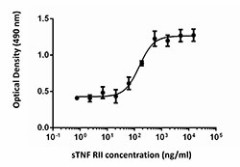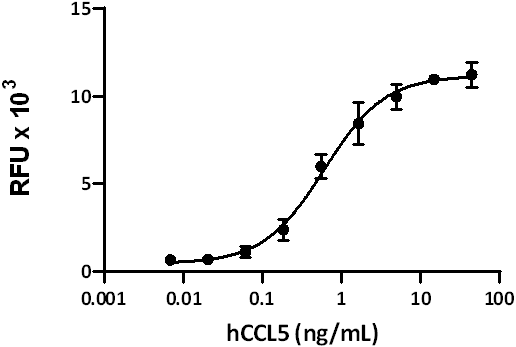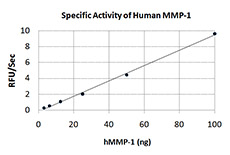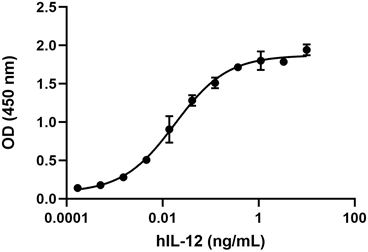- Regulatory Status
- RUO
- Other Names
- p75TNFR, cd120b, TNF RII, tumor necrosis factor receptor superfamily member 1B (TNFRSF1B), TNFBR, TNFR80, TNF receptor beta chain, p75 TNFR, p80 TNF-alpha receptor, tumor necrosis factor receptor 2.
- Ave. Rating
- Submit a Review
| Cat # | Size | Price | Quantity Check Availability | Save | ||
|---|---|---|---|---|---|---|
| 591602 | 10 µg | 118€ | ||||
| 591604 | 25 µg | 203€ | ||||
| 591606 | 100 µg | 549€ | ||||
The biological effects of TNF are mediated by two cell surface TNF receptors, TNF-RI and TNF-RII. TNF-RI and TNF-RII are structurally related but functionally distinct. Also, TNF-RI is widely expressed on most cells, whereas TNF-RII is more restricted and is primarily expressed in hematopoietic cells and cells of the immune system. The function of TNF-RII is less understood and has fewer biological effects than TNF-RI. Unlike TNF-RI, TNF-RII does not have death domain and will induce NF-κB activation through a different pathway. It is generally accepted that TNF-RI induces both apoptosis and survival pathways and TNF-RII induces only survival pathway. Only membrane-bound TNF can active TNF-RII effectively. Soluble TNF can bind TNF-RII but can not induce TNF-RII signaling. Upon binding of TNF, TNF-RII will form a trimer and recruit TRAF2, therefore leading to activation of NF-κB. In T cells, TNF-RII costimulation provides survival signals during the differentiation program trigger by TCR-mediated stimulation and also during clonal expansion in response to intracellular bacterial pathogens. Both TNF-RI and TNF-RII can be released from cell surface by ectodomain shedding. The resulting soluble TNF-RI and TNF-RII can bind TNF with high affinity and modulate TNF effects. An in vitro study showed that both TNF-RI and TNF-RII are constitutively released from monocytes. LPS stimulation can further increase soluble TNF-RII release. It has been reported that association of TNF-RII polymorphism with some lymphomas, solid tumors, and autoimmune diseases. The plasma level of soluble TNF-RII is increased in obese people and is related to insulin resistance. In addition, recombinant Fc-tagged soluble TNF-RII has been used to treat rheumatoid arthritis.
Product DetailsProduct Details
- Source
- Human TNF-RII, amino acids Pro 24-Thr206 with an N-terminal Met (Accession# AAA59929.1) was expressed in E. coli.
- Molecular Mass
- The 184 amino acid recombinant protein has a predicted molecular mass of approximately 20 kD. The DTT-reduced protein migrates at approximately 21 kD and the non-reduced protein migrates at approximately 19 kD by SDS-PAGE. The N-terminal amino acid is Met.
- Purity
- >95%, as determined by Coomassie stained SDS-PAGE.
- Formulation
- 0.22 µm filtered protein solution is in PBS.
- Endotoxin Level
- Less than 0.01 ng per µg cytokine as determined by the LAL method.
- Concentration
- 10 and 25 µg sizes are bottled at 200 µg/mL. 100 µg size and larger sizes are lot-specific and bottled at the concentration indicated on the vial. To obtain lot-specific concentration and expiration, please enter the lot number in our Certificate of Analysis online tool.
- Storage & Handling
- Unopened vial can be stored between 2°C and 8°C for up to 2 weeks, at -20°C for up to six months, or at -70°C or colder until the expiration date. For maximum results, quick spin vial prior to opening. The protein can be aliquoted and stored at -20°C or colder. Stock solutions can also be prepared at 50 - 100 µg/mL in appropriate sterile buffer, carrier protein such as 0.2 - 1% BSA or HSA can be added when preparing the stock solution. Aliquots can be stored between 2°C and 8°C for up to one week and stored at -20°C or colder for up to 3 months. Avoid repeated freeze/thaw cycles.
- Activity
- ED50 is 0.15-0.5 µg/ml, corresponding to a specific activity of 2-6 x 103 units/mg, as determined by a dose-dependent inhibition of 0.25 ng/ml TNF-α induced cytotoxicity in L929 mouse fibroblast cells in the presence of 4 µg/ml actinomycin D.
- Application
-
Bioassay
- Application Notes
-
BioLegend carrier-free recombinant proteins provided in liquid format are shipped on blue-ice. Our comparison testing data indicates that when handled and stored as recommended, the liquid format has equal or better stability and shelf-life compared to commercially available lyophilized proteins after reconstitution. Our liquid proteins are verified in-house to maintain activity after shipping on blue ice and are backed by our 100% satisfaction guarantee. If you have any concerns, contact us at tech@biolegend.com.
Antigen Details
- Structure
- Cytokine receptor
- Distribution
-
TNF-RII is expressed in T cell, astrocytes, oligodendrocytes, monocytes, endothelial cells, human mesenchymal stem cells, macrophages and Langerhans cells. Soluble TNF-RII can be detected in the urine and blood.
- Function
- TNF-RII transduce TNF signal through TRAF2. Soluble TNF-RII can neutralize the biological activity of TNF, dampening the inflammatory response. The level of circulating soluble TNF-RII is increased in patients with sepsis, cancer, HIV, and autoimmune disease.
- Ligand/Receptor
- TNF
- Cell Type
- Dendritic cells, Tregs
- Biology Area
- Apoptosis/Tumor Suppressors/Cell Death, Cell Biology, Immunology, Innate Immunity, Mitochondrial Function
- Molecular Family
- Cytokine/Chemokine Receptors, Soluble Receptors
- Antigen References
-
1. Hehlgans T and Mannel DN. 2002. Biol. Chem. 383:1581.
2. Glossop, et al. 2005. Arthritis. Res. Ther. 7:R1227.
3. Kollias G and Kontoyiannis D. 2002. Cytokine Growth Factor Rev. 13:135.
4. Gordon AC, et al. 2004. Genes Immun. 5:631.
5. Lantz M et al. 1990. Cytokine 2:402.
6. Nophar Y et al. 1990. EMBO. 9:3269.
7. Naude PJ et al. 2011. FEBS J. 278:888. - Gene ID
- 7133 View all products for this Gene ID
- UniProt
- View information about CD120b on UniProt.org
Related FAQs
- Why choose BioLegend recombinant proteins?
-
• Each lot of product is quality-tested for bioactivity as indicated on the data sheet.
• Greater than 95% Purity or higher, tested on every lot of product.
• 100% Satisfaction Guarantee for quality performance, stability, and consistency.
• Ready-to-use liquid format saves time and reduces challenges associated with reconstitution.
• Bulk and customization available. Contact us.
• Learn more about our Recombinant Proteins. - How does the activity of your recombinant proteins compare to competitors?
-
We quality control each and every lot of recombinant protein. Not only do we check its bioactivity, but we also compare it against other commercially available recombinant proteins. We make sure each recombinant protein’s activity is at least as good as or better than the competition’s. In order to provide you with the best possible product, we ensure that our testing process is rigorous and thorough. If you’re curious and eager to make the switch to BioLegend recombinants, contact your sales representative today!
- What is the specific activity or ED50 of my recombinant protein?
-
The specific activity range of the protein is indicated on the product datasheets. Because the exact activity values on a per unit basis can largely fluctuate depending on a number of factors, including the nature of the assay, cell density, age of cells/passage number, culture media used, and end user technique, the specific activity is best defined as a range and we guarantee the specific activity of all our lots will be within the range indicated on the datasheet. Please note this only applies to recombinants labeled for use in bioassays. ELISA standard recombinant proteins are not recommended for bioassay usage as they are not tested for these applications.
- Have your recombinants been tested for stability?
-
Our testing shows that the recombinant proteins are able to withstand room temperature for a week without losing activity. In addition the recombinant proteins were also found to withstand four cycles of freeze and thaw without losing activity.
- Does specific activity of a recombinant protein vary between lots?
-
Specific activity will vary for each lot and for the type of experiment that is done to validate it, but all passed lots will have activity within the established ED50 range for the product and we guarantee that our products will have lot-to-lot consistency. Please conduct an experiment-specific validation to find the optimal ED50 for your system.
- How do you convert activity as an ED50 in ng/ml to a specific activity in Units/mg?
-
Use formula Specific activity (Units/mg) = 10^6/ ED50 (ng/mL)

 Login / Register
Login / Register 



















Follow Us